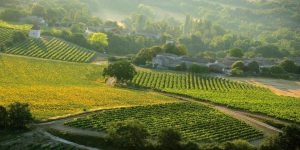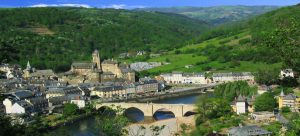I first met Chris and Andrea Mullineux in South Africa back in 2007 under the shade of a kindly old tree at the Tulbagh Mountain Winery (now Fable Wines). Over the course of a leisurely lunch they laid out their plans to move west; to a region then better known for wheat than wine – the Swartland.
Their eyes shone at the idea of setting up in this new frontier. It offered the ideal, Mediterranean climate to craft wines from the Rhône varieties they had come to love during their internship years in Southern France. They were also toying with the idea of producing a straw wine.
I caught up with Chris and Andrea in France a few times in the ensuing years and they gave modest accounts of their Swartland winemaking adventures. It wasn’t until I emerged from my sleepy Gigondas existence, and started following international press accounts, that I discovered their impressive rise in prominence.
Last week, I was offered the opportunity to taste through the current Mullineux Swartland range available here in Montreal. Mullineux’s sales director Nicola Tipping led us through the tasting, and explained the nuances of terroir that give each wine such distinctive personality.
The schist soils of the Kasteelberg bring structure, body, and freshness, while 40 km away the decomposed granite of the Paardeberg gives racier acidity and flinty minerality. Between the two rocky outcrops, iron-rich soils offer a grippier, more concentrated expression. Mullineux’s wines are a testament to these varied soils and to the region’s benevolent climate.
To me, the common thread throughout the tasting was a sense of harmony. The Chenin Blanc based white wines showed mouthwatering acidity perfectly pitched against bright fruit and/ or textural weight. The Syrah-dominant red wines were fairly bold and weighty as should be expected from this hot South African region, yet displayed lovely freshness and juicy fruit flavours. The oak imprint is subtle if at all noticeable, and the Syrah tannins are ripe and rounded.
And the straw wine?
The project did indeed come to fruition, garnering an impressive 96 points Wine Advocate in its first vintage. Each subsequent vintage has achieved similar scores and sells out quickly.
Want to try a Mullineux wine for yourself? Check out my tasting notes from the event, and see which wines are available near you.
Kloof Street Old Vine Chenin Blanc 2018, Swartland
Really bright fruit on the nose, with tropical nuances underscored by ripe lemon, yellow apple, and subtle stony mineral hints. Very clean on the palate, with piercing acidity, a round, juicy fruited core, and dry, citrus-driven finish. Cool fermented in tank and a small portion of neutral barrels.
Where to Buy: SAQ (22.20$), LCBO (19.70$)
Mullineux Old Vines White 2018, Swartland
A blend of mainly Chenin Blanc, with white Rhône varietals, and a splash of Sémillon Gris. Initially quite flinty, with aromas of ripe lemon, yellow apple, gooseberry, and anis developing with aeration. The palate shows lovely balance of racy acidity, lifting the weighty, creamy textured mid-palate nicely. Finishes dry, with attractive nutty flavours, and well integrated toasty oak hints. Barrel fermented with native yeasts. Aged 11 months in mainly 3rd and 4th fill French casks.
Where to Buy: LCBO (37.95$). Private import in Québec, enquire with agent: Rézin.
Mullineux “Granite” Chenin Blanc 2018, Swartland
Slightly muted on the nose, with nuances of yellow orchard and stone fruit, hints of marzipan, and flint. This impressive wine really comes alive on the palate, with its powerful, tightly wound expression, its depth of honeyed yellow fruit, its mouthwatering acidity, and lingering saline finish. Needs a few years in cellar to unfurl, but should be a stunner. 40-year-old, dry farmed Chenin Blanc grapes, grown in granite soils. Barrel fermented with native yeasts. Aged 11 months in mainly 3rd and 4th fill French casks.
Where to buy: Special release at SAQ in Feb. 2020 (95.00$), enquire with agent in Ontario: Nicolas Pearce Wines
Kloof Street Red 2017, Swartland
Predominantly Syrah, with a touch of old vine Cinsault and Carignan. An easy drinking red with attractive plum, red currant, and cherry aromas. Light, smooth, and rounded on the palate, with juicy red fruit flavours, and soft tannins. Partial whole bunch fermentation at cool temperatures. Brief maturation in neutral oak.
Where to buy: SAQ (22.90$), enquire with agent in Ontario: Nicolas Pearce Wines
Mullineux Syrah 2016, Swartland
Intense aromas of smoked meat, baked red and black fruit, and black olive tapenade feature on the nose. Dense and brooding on the palate, giving way to a bright, juicy fruited core bringing lift and freshness. Finishes dry, with muscular tannins, and hints of tobacco and sweet spice.
Where to buy: SAQ (46.00$), LCBO (47.00$)
Mullineux “Granite” Syrah 2016, Swartland
Very elegant Syrah, with an alluring nose of violets, dark chocolate, red currant, and baked black fruit, with a subtle gamey undertone. The palate is full-bodied and firm in structure, yet pleasingly suave in texture with ripe, polished tannins. Highly concentrated flavours of juicy red and black fruit mingle with meaty nuances, lingering long on the finish.
Where to buy: SAQ (145.00$), enquire with agent in Ontario: Nicolas Pearce Wines
Mullineux “Schist” Syrah 2016, Swartland
Similar in weight and concentration, but with more blue and black fruit on the nose, underscored by both game and herbal nuances. The palate displays an attractive chalky texture and fine-grained tannins; more sinewy in nature than the Granite. Finishes wonderfully fresh, with layers of vibrant dark fruit and refreshing herbal hints.
Where to buy: SAQ (140.00$), enquire with agent in Ontario: Nicolas Pearce Wines
Mullineux Straw Wine 2018, Swartland
Wonderfully fragrant, with notes of pineapple, apricot, candied lemon, and honey fairly leaping from the glass. Searing acidity cuts through the concentrated core and honeyed sweetness effortlessly, and provides lovely lift on the long, crystalline finish.
100% Chenin Blanc grapes are picked at optimal ripeness to preserve vibrant acidity. Grapes are dried 2 – 4 weeks on outdoor, shaded straw mats, leading to an evaporation of (up to) 80% of liquid. Cool, slow fermentation follows with native yeasts lasting upwards of 6 months in neutral barrels.
Where to buy: Sadly not available. Enquire with agents: Rézin, Nicolas Pearce Wines














